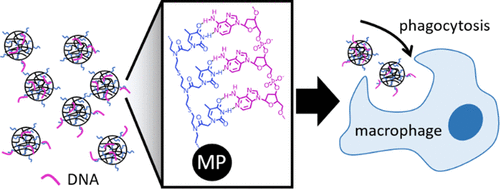当前位置:
X-MOL 学术
›
Biomacromolecules
›
论文详情
Our official English website, www.x-mol.net, welcomes your feedback! (Note: you will need to create a separate account there.)
Synthesis and Characterization of Click Nucleic Acid Conjugated Polymeric Microparticles for DNA Delivery Applications
Biomacromolecules ( IF 6.2 ) Pub Date : 2021-02-23 , DOI: 10.1021/acs.biomac.0c01563 Alex J Anderson 1 , Emerson Grey 1 , Nicholas J Bongiardina 2 , Christopher N Bowman 1, 2, 3 , Stephanie J Bryant 1, 2, 3
Biomacromolecules ( IF 6.2 ) Pub Date : 2021-02-23 , DOI: 10.1021/acs.biomac.0c01563 Alex J Anderson 1 , Emerson Grey 1 , Nicholas J Bongiardina 2 , Christopher N Bowman 1, 2, 3 , Stephanie J Bryant 1, 2, 3
Affiliation

|
Microparticle-mediated nucleic acid delivery is a popular strategy to achieve therapeutic outcomes via antisense gene therapy. However, current methods used to fabricate polymeric microparticles suffer from suboptimal properties such as particle polydispersity and low encapsulation efficiency. Here, a new particulate delivery system based on step-growth thiol-Michael dispersion polymerization is reported in which a low polydispersity microparticle is functionalized with a synthetic nucleic acid mimic, namely, click nucleic acids (CNA). CNA oligomers, exhibiting an average length of approximately four nucleic acid repeat units per chain for both adenine and thymine bases, were successfully conjugated to excess thiols present in the microparticles. Effective DNA loading was obtained by simple mixing, and up to 6 ± 2 pmol of complementary DNA/mg of particle was achieved, depending on the length of DNA used. In addition, DNA loading was orders of magnitude less for noncomplementary sequences and sequences containing an alternating base mismatch. The DNA release properties were evaluated, and it was found that release could be triggered by sudden changes in temperature but was unaffected over a range of pH. Finally, phagocytosis of loaded microparticles was observed by confocal microscopy and corroborated by an increase in cellular metabolic activity up to 90%. Overall, this work suggests that CNA functionalized microparticles could be a promising platform for controlled DNA delivery.
中文翻译:

用于 DNA 递送应用的点击核酸共轭聚合物微粒的合成和表征
微粒介导的核酸递送是通过反义基因治疗实现治疗效果的流行策略。然而,目前用于制造聚合物微粒的方法存在次优性能,例如粒子多分散性和低封装效率。在这里,报道了一种基于逐步生长硫醇-迈克尔分散聚合的新型微粒递送系统,其中低多分散性微粒用合成的核酸模拟物,即点击核酸 (CNA) 进行了功能化。对于腺嘌呤和胸腺嘧啶碱基,每条链平均长度约为四个核酸重复单元的 CNA 寡聚体成功地与微粒中存在的过量硫醇结合。通过简单的混合获得有效的 DNA 负载,根据所用 DNA 的长度,可实现高达 6 ± 2 pmol 的互补 DNA/mg 颗粒。此外,对于非互补序列和包含交替碱基错配的序列,DNA 加载量要少几个数量级。对 DNA 释放特性进行了评估,发现释放可以由温度的突然变化触发,但在一定 pH 值范围内不受影响。最后,通过共聚焦显微镜观察到负载微粒的吞噬作用,并通过细胞代谢活性增加高达 90% 得到证实。总体而言,这项工作表明,CNA 功能化微粒可能是一个有前途的受控 DNA 递送平台。对于非互补序列和包含交替碱基错配的序列,DNA 加载量要少几个数量级。对 DNA 释放特性进行了评估,发现释放可以由温度的突然变化触发,但在一定 pH 值范围内不受影响。最后,通过共聚焦显微镜观察到负载微粒的吞噬作用,并通过细胞代谢活性增加高达 90% 得到证实。总体而言,这项工作表明,CNA 功能化微粒可能是一个有前途的受控 DNA 递送平台。对于非互补序列和包含交替碱基错配的序列,DNA 加载量要少几个数量级。对 DNA 释放特性进行了评估,发现释放可以由温度的突然变化触发,但在一定 pH 值范围内不受影响。最后,通过共聚焦显微镜观察到负载微粒的吞噬作用,并通过细胞代谢活性增加高达 90% 得到证实。总体而言,这项工作表明,CNA 功能化微粒可能是一个有前途的受控 DNA 递送平台。通过共聚焦显微镜观察到负载微粒的吞噬作用,并通过细胞代谢活性增加高达 90% 得到证实。总体而言,这项工作表明,CNA 功能化微粒可能是一个有前途的受控 DNA 递送平台。通过共聚焦显微镜观察到负载微粒的吞噬作用,并通过细胞代谢活性增加高达 90% 得到证实。总体而言,这项工作表明,CNA 功能化微粒可能是一个有前途的受控 DNA 递送平台。
更新日期:2021-03-08
中文翻译:

用于 DNA 递送应用的点击核酸共轭聚合物微粒的合成和表征
微粒介导的核酸递送是通过反义基因治疗实现治疗效果的流行策略。然而,目前用于制造聚合物微粒的方法存在次优性能,例如粒子多分散性和低封装效率。在这里,报道了一种基于逐步生长硫醇-迈克尔分散聚合的新型微粒递送系统,其中低多分散性微粒用合成的核酸模拟物,即点击核酸 (CNA) 进行了功能化。对于腺嘌呤和胸腺嘧啶碱基,每条链平均长度约为四个核酸重复单元的 CNA 寡聚体成功地与微粒中存在的过量硫醇结合。通过简单的混合获得有效的 DNA 负载,根据所用 DNA 的长度,可实现高达 6 ± 2 pmol 的互补 DNA/mg 颗粒。此外,对于非互补序列和包含交替碱基错配的序列,DNA 加载量要少几个数量级。对 DNA 释放特性进行了评估,发现释放可以由温度的突然变化触发,但在一定 pH 值范围内不受影响。最后,通过共聚焦显微镜观察到负载微粒的吞噬作用,并通过细胞代谢活性增加高达 90% 得到证实。总体而言,这项工作表明,CNA 功能化微粒可能是一个有前途的受控 DNA 递送平台。对于非互补序列和包含交替碱基错配的序列,DNA 加载量要少几个数量级。对 DNA 释放特性进行了评估,发现释放可以由温度的突然变化触发,但在一定 pH 值范围内不受影响。最后,通过共聚焦显微镜观察到负载微粒的吞噬作用,并通过细胞代谢活性增加高达 90% 得到证实。总体而言,这项工作表明,CNA 功能化微粒可能是一个有前途的受控 DNA 递送平台。对于非互补序列和包含交替碱基错配的序列,DNA 加载量要少几个数量级。对 DNA 释放特性进行了评估,发现释放可以由温度的突然变化触发,但在一定 pH 值范围内不受影响。最后,通过共聚焦显微镜观察到负载微粒的吞噬作用,并通过细胞代谢活性增加高达 90% 得到证实。总体而言,这项工作表明,CNA 功能化微粒可能是一个有前途的受控 DNA 递送平台。通过共聚焦显微镜观察到负载微粒的吞噬作用,并通过细胞代谢活性增加高达 90% 得到证实。总体而言,这项工作表明,CNA 功能化微粒可能是一个有前途的受控 DNA 递送平台。通过共聚焦显微镜观察到负载微粒的吞噬作用,并通过细胞代谢活性增加高达 90% 得到证实。总体而言,这项工作表明,CNA 功能化微粒可能是一个有前途的受控 DNA 递送平台。

























 京公网安备 11010802027423号
京公网安备 11010802027423号